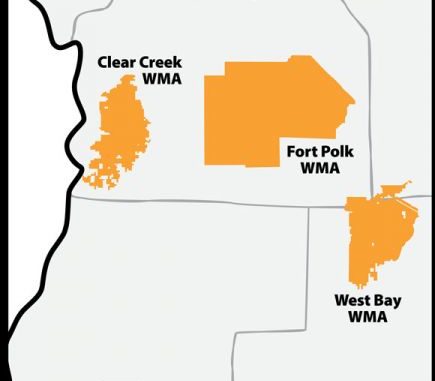
Sabine Island WMA
Acreage: 8,343
Parish: Calcasieu
Located near the Sabine River, close to the Texas border, this WMA is characterized by cypress-tupelo swamps and piney ridges. Hunters will likely find hardwoods like white oaks, sweetgum and willow oaks interspersed between loblolly pine. However, due to its small size, harvest opportunities may not be as high as some of the larger WMAs in the region.
Clear Creek WMA
Acreage: 52,559
Parish: Vernon
This huge tract of land is managed primarily as a loblolly pine plantation, with timber companies routinely cutting stands for lumber. However, Bordelon said this is advantageous for hunters. “The forest is always in motion and that’s good for the deer,” he said. “Those young pine stands and areas that have been thinned for the first or second thinning can be great areas to target and scout because of the new vegetation growth.”
While mostly upland pine habitat, between the ridges hunters can find pockets of hardwoods, and along creek bottoms more oaks, as well as huckleberry, greenbrier and honeysuckle. There is a public campground available year-round, offering plenty of room for both tents and campers.
West Bay WMA
Acreage: 59,189
Parish: Allen
Mill Creek flows through this WMA, but many smaller streams may be dry during the early archery season. Along the streambeds you can find hardwoods, although much of the habitat is pine plantation on mostly flat terrain. While deer may frequent hardwoods dropping acorns earlier in the season, once squirrel hunters take to the woods in October the animals will disperse. “Stick to transition areas and younger stands of pine,” Bordelon said.
Peason Ridge WMA
Acreage: 74,309
Parishes: Sabine, Natchitoches, Vernon
Rolling hills covered in loblolly and longleaf pines dominate this landscape, which is, to a lesser extent, crisscrossed by creeks with oaks, magnolias, maples, mulberries and azaleas. “You get in those bottoms and you can find loads of green briars,” Lack said. “The deer are eating that as they’re walking through first, then they’ll eat all the sage grass.”
Although there is no camping on the WMA, you can find plenty of options in nearby Kisatchie National Forest.
Fort Polk WMA
Acreage: 105,545
Parish: Vernon
This large-acreage tract is owned by the U.S. Army and is an active training facility. For this reason, many thousands of acres are often closed to hunting throughout the duration of the deer season. “When sections close down, the deer aren’t pressured for months, maybe a few years,” Lack said. “Those deer get bigger and can be 5 or 6 years old. That’s great news for hunters when those sections are opened back up.”
You can expect rolling hills and flatlands, prolific with longleaf pines. The tree once covered large portions of the southeastern U.S., but now only remains in small pockets. Deer feed on dropping acorns and, while the understory is sparse, there is browse available near creeks. According to the LDWF, land managers “plant approximately 110 acres of wildlife openings in the area each year with browntop millet, sunflower, sorghum, cowpea, and winter wheat.”